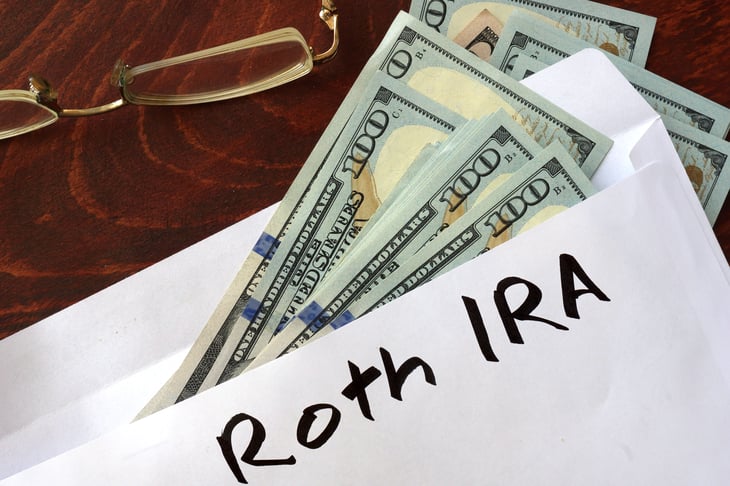
This story originally appeared on The Penny Hoarder.
Have you ever been in dire need of some cash but your bills are due and your bank account is low?
Then you look at your 401(k) sitting over there and think, “I could just take out a loan, problem solved.”
Wait. Before you get crazy with a loan that may not be in your best interest, you should know there are ways to get money out of retirement accounts without a loan or being subject to the 10% withdrawal penalty.
How to Get Money Out of Your Retirement Accounts Before 59 ½

According to a TPH analysis of microdata from the Federal Reserve Board’s latest financial wellness survey, 1 in 10 Americans under the age of 60 borrowed money or withdrew early from one of their retirement accounts in the last year.
Once you put money into your 401(k) or IRA, if you try to access it before the age of 59 ½ it’s typically through a 401(k) loan or paying a 10% penalty on the withdrawal in addition to any applicable taxes.
While we advise having an emergency fund over resorting to retirement savings, sometimes life comes at you fast and you need that money. And if you’re using it for the right reasons, we think you shouldn’t be penalized for using money that’s yours to begin with.
So here are some of the ways you can get money out of those accounts without fees, penalties or restrictive loan terms.
1. Contribution Withdrawals From a Roth IRA

The Roth IRA is your most flexible account in retirement because you don’t have to pay taxes on withdrawals, no matter how large your growth, and it’s the only account without required minimum distributions.
Your Roth IRA also offers you the most flexible options when you need to pull money from retirement. You can withdraw contributions you’ve made at any time tax-free and without penalty.
This applies only to the contributions, not the earnings of your Roth IRA.
2. Disability Exemption

If you become physically or mentally disabled and are unable to work, you can take distributions from any retirement account penalty-free.
Once a physician certifies that the physical or mental impairment is continuous and of long or indefinite duration, all retirement accounts become available as they would at 59 ½ — which means even though there’s no penalty, you’re still subject to federal and state taxes.
3. Home Purchase

You can withdraw up to the lifetime maximum of $10,000 — $20,000 for couples — from an IRA (Roth or traditional) to buy or build a home. To qualify, you cannot have owned a home in the two years preceding the home purchase.
But because you can withdraw contributions from your Roth IRA penalty-free, those limits apply only to earnings.
The caveat is that if the account is less than five years old and you decide to withdraw earnings, you will have to pay income taxes on those.
If you prefer to withdraw from a traditional IRA, your maximum is a straight $10,000. You will have to pay applicable taxes on it. If you have both and think you’ll need to dip into earnings for the withdrawal, the traditional IRA is the account to go with because it’s easier to grow the balance through 401(k) rollovers.
4. Health Insurance Costs

If you lose your job and collect unemployment compensation for 12 consecutive weeks, you can use your IRA to pay for health insurance for you, your spouse and your dependents.
Since you can use Roth IRA contributions for any reason, this is more notable for a traditional IRA.
5. Big Medical Expenses

Medical expenses not reimbursed by insurance can qualify for a penalty waiver. Those expenses would need to exceed 10% of your adjusted gross income if you’re withdrawing from an IRA and 7.5% to withdraw from a 401(k). The distribution can be used for you, your spouse or your dependents.
The distribution has to be made in the same year that the medical expense is incurred, which could be difficult if you have an accident taking down the Christmas lights on Dec. 31 — another reason to leave them up until January.
If that all sounds intimidating and vague, that’s because it is. You’ll definitely need to consult a certified public accountant and your plan provider if you decide to go this route.
A better option is contributing to a health savings account (HSA) if you have one available to you. For medical expenses, an HSA is more flexible, easier to access and more tax-advantaged than any other retirement account.
6. Military Service

Qualified reservists can take distributions from an IRA, 401(k) or 403(b) during an active duty of more than 179 days.
This includes all Reserve and National Guard members. While other distributions put you at a loss, qualified reservist distributions (QRDs) are allowed to be paid back in full for up to two years after your active duty ends, even if those extra contributions exceed the annual limit.
7. College Costs

If you, your spouse, child or grandchild are pursuing higher education, it can be paid for from your IRA without penalty. Qualified expenses include tuition, fees, books, supplies and — if enrolled at least half time — room and board.
While this is only a benefit of an IRA, you can also roll over a 401(k) into a traditional IRA to pay for college. But understand that withdrawals for college costs can reduce your or your student’s eligibility for financial aid.
And if you’re thinking about using your retirement account to save for college, stop right there! 529 plans were designed for just that.
8. Change of Employment

If you leave your job in the year you turn 55 — or any time after — you can withdraw from your 401(k). If you anticipate retiring around this age and have any old 401(k)s lying around, this would be a good reason to roll it over to your current 401(k) instead of a traditional IRA.
Bonus: If you’re a government employee with a 457(b), you can access those retirement savings penalty-free whenever you leave your job, no matter your age.
9. Annual Distributions

If you’re trying to retire earlier than 55, you can agree to withdraw a specific amount every year called substantially equal periodic payments (SEPPs). You’ll basically need to agree to take consistent withdrawals, based on IRS calculations, each year for the rest of your life.
The calculations are a bit confusing, so this is another one you’ll need to consult a financial adviser for. They can also tell you if SEPPs are your best option for early retirement or if there’s something more flexible that still gets you around the 10% penalty.
In conclusion, every time you take money out of a retirement account, you lose out on the compounding interest that money could have earned you. None of these should be go-to methods for getting extra money but they are available if you need them.





Add a Comment
Our Policy: We welcome relevant and respectful comments in order to foster healthy and informative discussions. All other comments may be removed. Comments with links are automatically held for moderation.